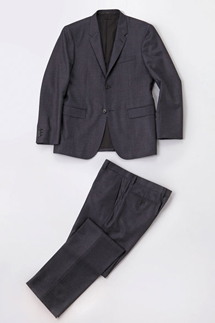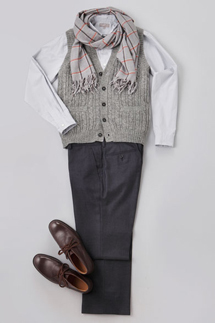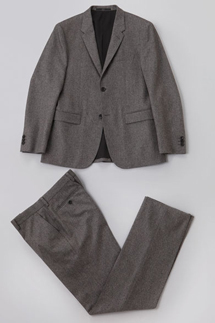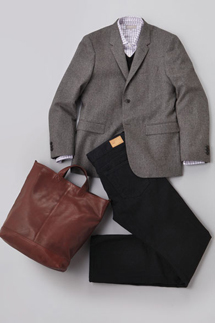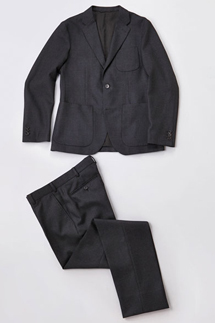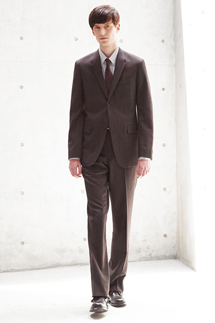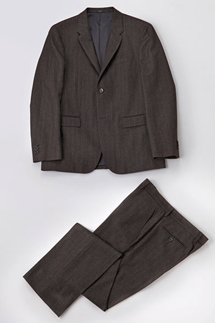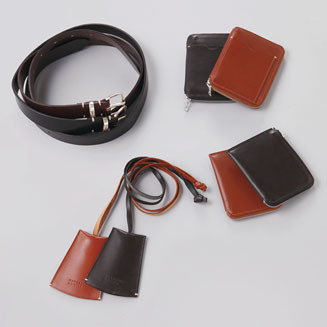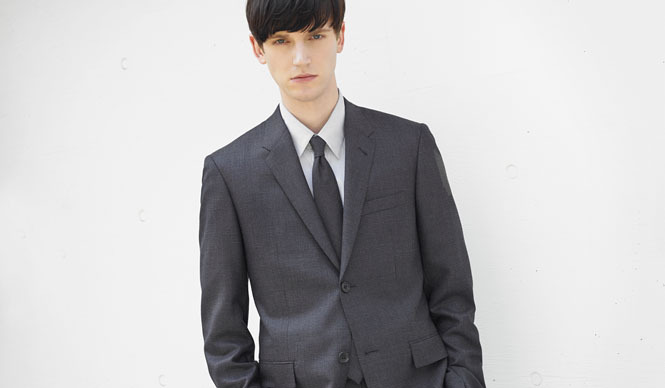
FASHION /
MEN
2015年4月7日
MARGARET HOWELL|“A GUIDE TO DRESS”セットアップは上質な日常着
MARGARET HOWELL|マーガレット・ハウエル
A GUIDE TO DRESS──この秋冬は、ドレスアイテムの着こなしが楽しい
セットアップは、上質な日常着(1)
スタイリッシュで、着回しが利いて、上品。そして着こむほど自分の体型になじんでいくのが、セットアップというアイテムである。“日常で着られるドレス服”として重宝するセットアップは、もちろんスーツより自由度が高い。この秋冬ならニットベストやバブアーのアウター、デニムトラウザーズなどを合わせると、よりデイリーな感覚で着こなすことができる。マーガレット・ハウエルのフィロソフィーが息づく上質なセットアップを、新鮮なスタイリングで楽しんでほしい。
Text by KAJII Makoto (OPENERS)Photographs by OHMORI SunaoHair&make by ReinaModel by James Allen
MARGARET HOWELL“A GUIDE TO DRESS”Autumn Winter 2013
SET-UP STYLE 1=P.O.Wの着こなし
グレンチェックが醸し出す正統英国調を、タイドアップでストイックにアピール
<FABRIC>
オリジナル生地をフォックスブラザーズに別注し、今の時代にフィットする軽やかなセットアップを提案するマーガレット・ハウエル。上のジャケットとトラウザーズの素材は、ウェールズ公(のちのエドワード7 世)が皇太子時代に狩猟用のウェアに愛用したことから名づけられた“P.O.W(プリンス・オブ・ウェールズ)”で、英国流がより奥深く解釈される今年の秋冬の着こなしにぴったり。
<STYLING>
人気の柄“プリンス・オブ・ウェールズ”と、同柄・素材のネクタイでより秋冬らしくクラシックに装うタイドアップがオンなら、オフは、トラウザーズにニットベストとスカーフで、清潔感のある男らしさを演出。
MARGARET HOWELL“A GUIDE TO DRESS”Autumn Winter 2013
SET-UP STYLE 2=TWILL FLANNELの着こなし
今シーズン“グレー”の着こなしは、シンプルなセットアップで美学をものにする
<FABRIC>
英国製ならではのじっくりと時間をかけて織り上げた生地は、手に取るだけで良さが伝わってくる。下のフォックスブラザーズ独特のソフトでコシのある素材感が楽しめる“ツイルフランネル”素材は、起毛が温かみをアピールすると同時に、知的で洗練された印象もあたえる。ワードローブに一着は揃えておきたい逸品だ。
<STYLING>
ツイルフランネルのグレーと、白のシャツとネイビーのタイで引き締まった男性美を柔らかい印象で着こなす。また、チェックのシャツにジョン・スメドレーへの別注ニットと、エドウインのブラックデニムで、グレーのジャケットがもつ軽快な洒脱感を楽しむのも新鮮。
MARGARET HOWELL|マーガレット・ハウエル
A GUIDE TO DRESS──この秋冬は、ドレスアイテムの着こなしが楽しい
セットアップは、上質な日常着(2)
MARGARET HOWELL“A GUIDE TO DRESS”Autumn Winter 2013
SET-UP STYLE 3=WOOL MELANGE TWILLの着こなし
纏うというより羽織るというライトな感覚で、カジュアルに着こなせるセットアップの魅力
<FABRIC>
ドレスクロージングに求められる堅いイメージをキープしながら、ナチュラルな風合いとこなれたニュアンスを備える、秋冬らしい“メランジツイル”素材。初秋に着こなしやすい軽さも魅力だ。テクスチャーの奥深い表情が着こなしをさりげなく上品に見せる。
<STYLING>
カジュアル感の強い3パッチポケットジャケットに、エドワーディアンカラーのドレスシャツ&ニットタイを合わせてグッと上品に仕上げる一方、ジャケットを生かして、エドウイン別注のペインタートラウザーズでプレッピーテイストを楽しむ。
MARGARET HOWELL“A GUIDE TO DRESS”Autumn Winter 2013
SET-UP STYLE 4=BRUSHED STITCH STRIPEの着こなし
今シーズンも気になるフォックスブラザーズ。茶系のフランネルで、新鮮コーディネイト
<FABRIC>
マーガレット・ハウエルが1970年にブランドを立ち上げた当初から愛用している「フォックスブラザーズ」の生地。フランネルの生みの親だけあって、生地をつかんでみると柔らかい感触が戻っている感じは、着こなしの快適さにそのまま直結する。下の“ブラッシュド ステッチ ストライプ”は保温性が高いのも特徴で、秋冬には欠かせないファブリックだ。
<STYLING>
オンは、着込むほどに味わいを増す秋冬の万能素材ライトフランネルで、大人の茶色の着こなしを楽しんだら、オフは、マーガレット・ハウエルが型から別注したバブアーのM65タイプが主役。着こなしやすいライトウエイトのオイルドジャケットで、肌に触れる襟や袖にはコーデュロイを使い、カントリースタイルをモダンに仕上げた一着。
MARGARET HOWELL|マーガレット・ハウエル
A GUIDE TO DRESS──この秋冬は、ドレスアイテムの着こなしが楽しい
セットアップは、上質な日常着(3)
MARGARET HOWELL“A GUIDE TO DRESS”Autumn Winter 2013
DRESS ITEMS
定番の2ウェイレザートートに新色(下左)
2007年秋冬からスタートしたポーターとのコラボレーションは、マーガレット・ハウエルに欠かせない定番アイテムとして定着。毎年進化をつづけているが、今季は新色ブラウンが登場する。しっとりと手に吸い付くような手触りの革を用いたレザーカジュアルバッグで、革の軽さや柔らかさを最大限に生かせるように金具を少なくし、内装はシンプルに仕上げて軽量でソフトなのも魅力。
2ウェイショルダーバッグ各5 万8800 円(マーガレット・ハウエル)
長年使い込めるレザー小物(上右)
1875年の創業から、高品質の馬具や洗練されたデザインのベルトや革小物を世に送り出している老舗メーカーへの別注品。
強く耐久性のあるイングリッシュブライドルレザーを経験豊かな職人が伝統の技術で仕上げていく。使い込むほど独特の風合いが出るレザーグッズは、愛着が沸く逸品揃いで、ラウンドファスナーのウォレットやキーフォブ(キーホルダー)はギフトにも最適。
マーガレット・ハウエルではそれぞれ2色展開。
ベルト各4万8300 円、ウォレット各3万1500円、ウォレット各3万5700円、キーフォブ各8400円(マーガレット・ハウエル)
細部にこだわった別注ブーツ(下左)
ハンドソーンウエルテッド製法ながら、コストパフォーマンスの高い靴を提案するペグマン。履き心地とシェイプに重点を置き、手間のかかる作りから生まれるスタンダードなユーティリティシューズは、まさにマーガレット・ハウエルのもの作りの哲学そのもの。
今シーズンはチャッカブーツを別注、レザー選びからアイレットなどパーツの組み合わせまで細かくオーダーし、ほどよいカジュアル感を残した一足となっている。
チャッカブーツ各4万9350円(マーガレット・ハウエル)
マーガレット・ハウエル オリジナル(上右)
タイドアップでも、ノータイでも、襟もとがスマートに美しく見えるように、台襟が高くデザインされているマーガレット・ハウエルのドレスシャツは、今シーズンもバリエーション豊富。とくにジャケットと同素材のフォックスブラザーズの布帛(ふはく)ネクタイは、今シーズンの筆頭注目アイテム。ジャケットとネクタイをペアにするとすっきり上品なセンスアップが叶う。
シャツ各2万7300円~3万450円、ネクタイ各1万4700円~1万5750円(マーガレット・ハウエル)
アングローバル
Tel. 03-5467-7874
http://www.margarethowell.jp

